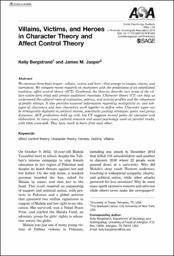
ATTENTION: The works hosted here are being migrated to a new repository that will consolidate resources, improve discoverability, and better show UTA's research impact on the global community. We will update authors as the migration progresses. Please see MavMatrix for more information.
Show simple item record
| dc.contributor.author | Bergstrand, Kelly | |
| dc.contributor.author | Jasper, James M. | |
| dc.date.accessioned | 2020-11-09T17:22:29Z | |
| dc.date.available | 2020-11-09T17:22:29Z | |
| dc.date.issued | 2018 | |
| dc.identifier.issn | 0190-2725 | |
| dc.identifier.uri | http://hdl.handle.net/10106/29586 | |
| dc.description.abstract | **Please note that the full text is embargoed** ABSTRACT: We examine three basic tropes—villain, victim, and hero—that emerge in images, claims, and narratives. We compare recent research on characters with the predictions of an established tradition, affect control theory (ACT). Combined, the theories describe core traits of the villain-victim-hero triad and predict audiences’ reactions. Character theory (CT) can help us understand the cultural roots of evaluation, potency, and activity profiles and the robustness of profile ratings. It also provides nuanced information regarding multiplicity in, and subtypes of, characters and how characters work together to define roles. Character types can be strategically deployed in political realms, potentially guiding strategies, goals, and group dynamics. ACT predictions hold up well, but CT suggests several paths for extension and
elaboration. In many cases, cultural research and social psychology work on parallel tracks, with little cross-talk. They have much to learn from each other. [This is a postprint of an article published by SAGE Publications/American Sociological Association in Social Psychology Quarterly (SPQ) on 2018. DOI: 10.1177/0190272518781050] | en_US |
| dc.language.iso | en_US | en_US |
| dc.publisher | SAGE, American Sociological Association | en_US |
| dc.relation.ispartofseries | Social Psychology Quarterly; | |
| dc.subject | affect control theory | en_US |
| dc.subject | character theory | en_US |
| dc.subject | heroes | en_US |
| dc.subject | victims | en_US |
| dc.subject | villains | en_US |
| dc.title | Villains, Victims, and Heroes in Character Theory and Affect Control Theory | en_US |
| dc.type | Article | en_US |
Files in this item
- Name:
- BergstrandJasperSPQPostprint_r ...
- Size:
- 364.3Kb
- Format:
- PDF
- Description:
- PDF
This item appears in the following Collection(s)
Show simple item record


